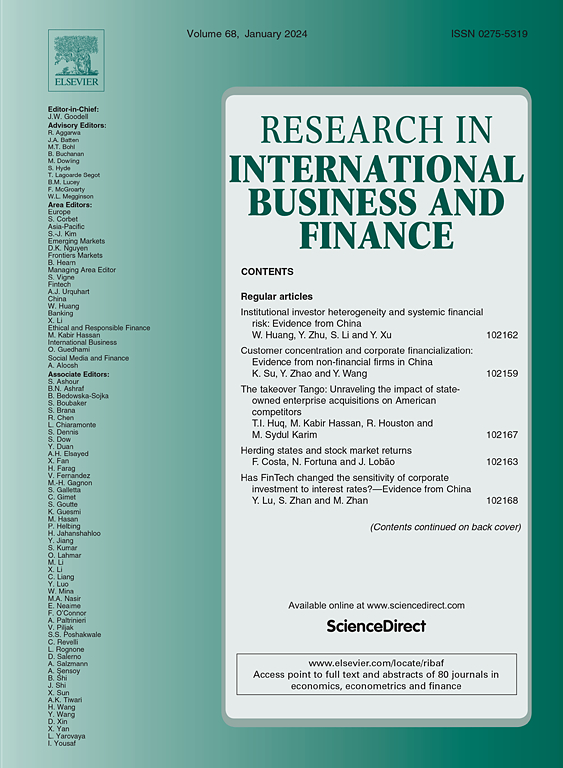中国商品期货市场与国际绿色金融市场的风险溢出效应及投资组合策略
IF 6.9
2区 经济学
Q1 BUSINESS, FINANCE
Research in International Business and Finance
Pub Date : 2025-07-01
DOI:10.1016/j.ribaf.2025.103076
引用次数: 0
摘要
本文研究了中国商品期货市场与国际绿色金融市场之间的风险溢出和投资组合优化问题。利用最大重叠离散小波变换(MODWT)和基于滚动窗口向量自回归的Diebold-Yılmaz溢出指数模型,结合复杂网络分析,研究了不同时间频率和网络结构下的风险溢出。研究结果表明,风险溢出发生在多个时间尺度上,国际绿色金融市场一直发挥主导作用,特别是通过绿色股票市场。尽管中国商品期货市场总体上表现出相对温和的溢出效应,但其重要性随着时间尺度的增加而变得更加明显。风险溢出网络分析表明,极端事件发生时市场间的风险传导加剧,事件的严重程度直接影响网络的复杂性。此外,在中长期尺度上,风险溢出网络中更紧密的联系强调了投资者需要优先考虑这些时期。不同投资策略下的投资组合优化模拟表明,国际绿色金融市场通过有效促进多元化,对中国商品期货市场绩效的提升具有重要作用。对于旨在加强宏观审慎监管的监管机构和寻求更好地管理风险的投资者来说,这些见解可能非常有价值,可以增强对跨市场风险传导机制的理解。本文章由计算机程序翻译,如有差异,请以英文原文为准。
Risk spillover effect and portfolio strategy between Chinese commodity futures market and international green finance market
This study investigates risk spillover and portfolio optimization between the Chinese commodity futures market and the international green finance market. Using the maximum overlapping discrete wavelet transform (MODWT) and a rolling window vector autoregression-based Diebold–Yılmaz spillover index model, combined with complex network analysis, this study examines risk spillover across different time frequencies and network structures. The findings reveal that risk spillover occurs across multiple time scales, with the international green finance market consistently playing a dominant role, particularly through the green stock market. Although China’s commodity futures market shows a relatively modest overall spillover effect, its significance becomes more pronounced with increasing time scales. The risk spillover network analysis indicates that risk transmission between markets intensifies during extreme events, with the severity of each event directly influencing the complexity of the network. Moreover, the denser connections in the risk spillover network at medium- and long-term scales emphasize the need for investors to prioritize these periods. Portfolio optimization simulations under various investment strategies demonstrate the role of international green finance market in enhancing the performance of China’s commodity futures market by effectively enhancing diversification. These insights may be highly valuable for regulatory bodies aiming to bolster macroprudential regulation and for investors seeking to better manage risks, enhancing the understanding of cross-market risk transmission mechanisms.
求助全文
通过发布文献求助,成功后即可免费获取论文全文。
去求助
来源期刊

Research in International Business and Finance
BUSINESS, FINANCE-
CiteScore
11.20
自引率
9.20%
发文量
240
期刊介绍:
Research in International Business and Finance (RIBAF) seeks to consolidate its position as a premier scholarly vehicle of academic finance. The Journal publishes high quality, insightful, well-written papers that explore current and new issues in international finance. Papers that foster dialogue, innovation, and intellectual risk-taking in financial studies; as well as shed light on the interaction between finance and broader societal concerns are particularly appreciated. The Journal welcomes submissions that seek to expand the boundaries of academic finance and otherwise challenge the discipline. Papers studying finance using a variety of methodologies; as well as interdisciplinary studies will be considered for publication. Papers that examine topical issues using extensive international data sets are welcome. Single-country studies can also be considered for publication provided that they develop novel methodological and theoretical approaches or fall within the Journal''s priority themes. It is especially important that single-country studies communicate to the reader why the particular chosen country is especially relevant to the issue being investigated. [...] The scope of topics that are most interesting to RIBAF readers include the following: -Financial markets and institutions -Financial practices and sustainability -The impact of national culture on finance -The impact of formal and informal institutions on finance -Privatizations, public financing, and nonprofit issues in finance -Interdisciplinary financial studies -Finance and international development -International financial crises and regulation -Financialization studies -International financial integration and architecture -Behavioral aspects in finance -Consumer finance -Methodologies and conceptualization issues related to finance
 求助内容:
求助内容: 应助结果提醒方式:
应助结果提醒方式:


